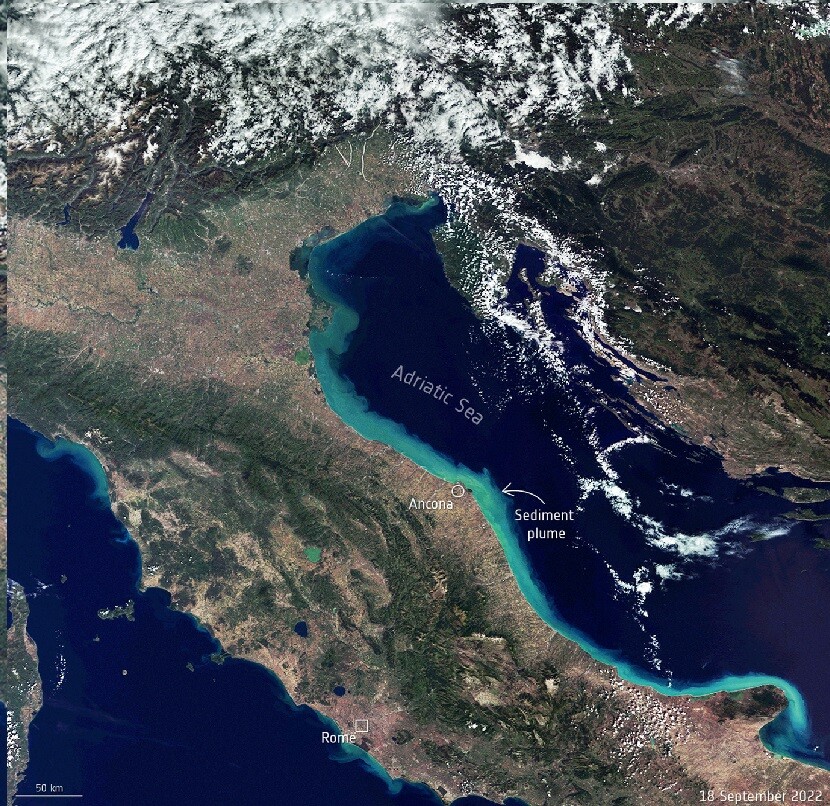By Christophe Bosquillon

On May 23-25 2023, we attended (online) GLOC2023: The Global Space Conference on Climate Change 2023, organized under the patronage of the International Astronautical Federation (IAF) and its member the Norwegian Space Agency (NOSA).
We found a neat improvement regarding the depth and quality of panels in comparison with GLOC 2022. But our community is still coming short of GLOC 2023 stated goal “Fire and Ice – Space for Climate Action”. That is not due to a lack of effort by organizers trying hard to deliver proactive steps beyond “blah-blah-blah”. We might want to credit GLOC 2023 with showing clearly what doesn’t work and where we should get our act together. We believe many among us will have appreciated the way Emma Gatti asked the hard questions. Thus departing from a general self-congratulatory attitude of re-arranging the chairs on the deck of the Titanic, while taking more X-rays of the broken knee to just make sure it’s really broken. There were clues and cues about how to communicate properly with the public on issues that are of daily concern to all of us. On how all these global disruptions will affect us in our local realities.
On 80% wasted Earth Observation (EO) data and a failure in appropriate localisation of data/information/actionable insights value chains, like we don’t care about end-users (the shocking issue of waste as reported in the opening high-level plenary is acknowledged as “95% of pixels are unusable” by some EO operators in contexts independent from GLOC). This double tragedy was embodied by Tom Gardner, from the Maldives Space Research Organisation (MSRO): Tom was on the panel to represent the Maldives Delegation, who had been denied a visa to attend GLOC 2023. Indeed, we solve nothing if we don’t start by solving communication, localization, and inclusion issues.
A rather simple framework when dealing with a crisis
In this world and era, we are facing crisis upon crisis on a global scale. There is no shortage of “frameworks for crisis management” to deal with an event that has a “before”, a “during”, and an “after”. However, climate change, irreversible and open-ended, compels us to revert to a simple 3-steps framework that should be respected. Such framework indicates that first, we should deal with the symptoms, second, we should deal with the consequences, and third, we should tackle the root causes.
- Dealing with the symptoms: these are climate indicators and weather events running amok. We need to keep monitoring these, as precisely as we can, and iterate endlessly backward and forward, to understand gaps between past models and reality, and to improve predictive models. That may help take mitigating measures if people know better when and how the sky will fall on their heads.
- Dealing with the consequences: these are existential disruptions to terrestrial ecosystems and human societies. It includes the impact of extreme events such as heat/drought/humidity, but also how diseases spread. In addition to rising sea levels, it’s about physical destruction by fire and flooding, disrupted agriculture, managing water availability and quality at scale, etc. It has a direct impact on starvation, poverty, inflation, and potentially massive migratory pressure. EO data covers it.
When the third point comes, that’s where the issues start. GLOC 2023 is extremely useful to get the message across regarding points 1 and 2, dealing with symptoms and consequences: we need to do a better job on space vs. non-space coordination. As one speaker said, this must be better than the multidisciplinary juxtaposition of people who work in silos: communicate, coordinate, cooperate are three key concepts. Addressing end-users with relevant and localised data/info/actionable insights is an issue to be addressed: there is room for business models with less EO data waste and better targeting of actionable insights. Then there are support services for dealing with consequences.
This is a planetary problem we need to tackle as united Europeans.
The question comes again and again in any space conference: which data/info/insights is a public good to be shared, and which require a paying customer, and in the latter case, who is to pay? Same question for support services. In this kind of business-as-usual conferences, there is also the elephant that is not in the room: vision without funding is a hallucination.
When it comes to dealing with the symptoms and dealing with the consequences, we still have many gaps but a somewhat clear view of how space, through EO and relevant tech, can contribute to solving problems in concert with terrestrial systems. Let’s have a look at point 3, tackling the root causes.
Space for Climate Action should also mean dealing with the root causes of climate change.
Curbing greenhouse gas emissions cannot be defined as “Space for Climate Action”. Despite all Net Zero rhetoric, it looks like we need fossil fuels so desperately on a planetary scale that moving from over 80% reliance on fossil fuels to no use within a couple of decades will simply not happen, regardless of what Europe does: for now building more solar/wind, having friction on nuclear, reopening more coal plants, still massively using oil and gas, and not quite sure yet whether hydrogen will work at all, etc.
This said, there are two topics that look like they could belong to a conference about “Space for Climate Action”. The first topic is Space-Based Solar Power, on which SWGL has reported here, here, and here. This is being studied globally including by ESA with SOLARIS, and the goal is to develop a stable baseload energy supply that is controllable and can be piloted to match demand. It’s not a small deal if it can end up replacing, say, 10 to 20% of global fossil fuel consumption.
A second topic is moving some industrial production to Earth orbit and near/on the Moon. While both topics may sound far-fetched, both have 2040-70 as startup timelines: that’s also exactly when we start running out of fossil fuels, while carbon impact still worsens. Indeed, we will enjoy a triple whammy of: environmental destruction; the end of a cheap energy supply covering over 80% of our worldwide needs; and the exponential increase in energy demand -coming from both the Global South and the seemingly energy-voracious digital transformation. As reported for SRW 2023 here, there is a case for Space Resource Utilization to provide propellant, materials, and components to build and maintain both space solar power and manufacturing facilities, starting with the Moon.
There is also the elephant that is not in the room: vision without funding is a hallucination.
Question: should these topics, SRU, SBSP, space manufacturing, become part of the agenda “Space for Climate Action”? Or is it a Pandora’s box (can of worms) the IAF might keep separated from the established GLOC agenda, centred on EO data and orbital support services for monitoring, crisis management, and mitigation? Even if these two topics do not become part of the agenda, there is still room for improvement in tackling the root causes, and curbing greenhouse gases emissions. For example, GLOC 2023 revealed that GHGSat and MethaneSAT are doing outstanding work in tracking and quantifying greenhouse gases emission. This could be used to track fossil fuel producers and all industrial and logistic value chains that claim to “decarbonize”, starting with energy generation systems, global transportation, cities, agriculture, etc. From material extraction to manufacturing to delivery, every solar panel and wind turbine relies on a value chain essentially supported by fossil fuels, so far, and so do electric car carcasses and batteries. Enough with naïveté. Somewhere there is a GenZ Erin Brockovich of climate change who will use that space and terrestrial data to sue corporations until they comply one way or another. Lawfare can be a potent weapon.

What more can we do?
One key issue is funding and differentiating government procurement from market economy mechanisms, while VCs play the role of subsidising some of the R&D. We can emphasise entrepreneurship + VCs in climate change “remediation” in and outside Europe, with a use of space infrastructure and EO data. In Europe, considering we still need Norway for oil and gas supplies while filling their Sovereign Wealth Fund coffers, it would be interesting to know how willing they are to invest in relevant space and terrestrial climate remediation business, including SBSP.
At the same time, let’s bear in mind that in the data/info/actionable insights value chain, decision-makers, and those who deal with the consequences of the crisis, couldn’t care less which part of the data comes from which satellites vs which terrestrial systems, and how much space has to be credited for turning around their predicament. What matters for them is the relevance of final outputs, or, as Tom Gardner would put it when representing the Maldives, how “international narrative meets local reality”.
All generations around the world need to unite!
Sahba El-Shawa intervened on Day 2 of GLOC2023 during the session “Saving our future on Earth through our presence: a generational exchange on the role of space in the fight against climate change” which can be watched here. Sahba delivered the first keynote in her role as Ethics and Human Rights and Space for Climate Action Lead at Space Generation Advisory Council, together with her co-lead, Giulia Bordacchini. As part of the Space Generation Advocacy and Policy Platform, their group developed a united space policy position on behalf of the youth of the SGAC. Besides environmental and space business, legal, and technological aspects, recommendations cover ethical, political, educational, and outreach issues that are pivotal in their work. We found this presentation totally relevant to how we should be working as a community and would like to see this intervention being presented as an example for various stakeholders to not lose sight of what matters for space relevant to humanity and Earth. In that sense, we were a bit puzzled to learn at GLOC 2023 that many senior panelists excused themselves when asked to participate in a discussion with the younger generation: hopefully, that too will change.
We should evidently develop a productive relationship with the Norwegian Space Agency, they and the IAF leadership get it, so that’s a positive. This is a planetary problem we need to tackle as united Europeans. Europe should contribute energetically to federate all concerned stakeholders, so they acknowledge the value of relevant space data. Start with member states, the energy sector, green tech value chains, secured material supplies, and industries to decarbonize. Find a common ground so everyone gets it. Include the Global South and make sure a Maldives Delegation is given a visa. Find an actionable path between denial and panic. And involve the public in solving the problem.

Christophe Bosquillon has a diverse professional background, having operated globally with a focus on the Indo-Pacific region. His experiences in Japan, the Koreas, Taiwan, China, ASEAN, India, Russia, and Australia have given him a deep understanding of the multipolar realpolitik of our world under the Pax Americana. With a background in engineering, trade, and foreign direct investment in industries relevant to Space Resource Utilization (SRU), such as mining, transportation, energy, manufacturing, agrifood, environment, and digitalization, Chris is committed to developing SRU value chains that benefit the Earth. As an executive, owner, writer, and founder of Autonomous Space Futures Ltd, Chris has extensive experience in collaborative policy crafting and works to develop space business and governance models relevant to society. He is a member of NGOs that provide input to the United Nations Committee on the Peaceful Uses of Outer Space (UNCOPUOS) legal subcommittee Working Group on Space Resources. Chris contributes to regulatory clarity on appropriation, priority, sustainability, and sharing in a way that balances national interests with civil society inclusion, provided a transparent due process is followed. When advocating for access to technology and space for the Global South, Chris believes that emerging space powers’ participation in space markets must be commensurate with their interest and involvement in international space politics. He believes that their ability to develop sovereign domestic capabilities with spillover potential is also essential. Chris is keen on ‘Peace Through Strength’ diplomacy and deterrence-based security as enablers of secure space access. He supports sovereign cislunar space situational awareness as mandatory for freedom of circulation in the space domain and deconflicted cooperation on the Moon.
 SpaceWatch.Global An independent perspective on space
SpaceWatch.Global An independent perspective on space




